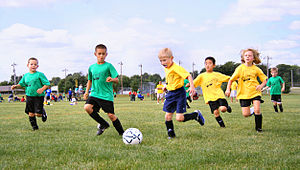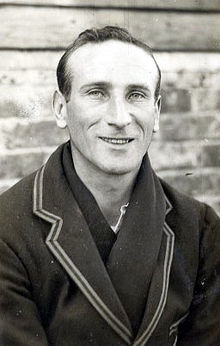The Sports Portal

Sport is a form of physical activity or game. Often competitive and organized, sports use, maintain, or improve physical ability and skills. They also provide enjoyment to participants and, in some cases, entertainment to spectators. Many sports exist, with different participant numbers, some are done by a single person with others being done by hundreds. Most sports take place either in teams or competing as individuals. Some sports allow a "tie" or "draw", in which there is no single winner; others provide tie-breaking methods to ensure one winner. A number of contests may be arranged in a tournament format, producing a champion. Many sports leagues make an annual champion by arranging games in a regular sports season, followed in some cases by playoffs.
Sport is generally recognised as system of activities based in physical athleticism or physical dexterity, with major competitions admitting only sports meeting this definition. Some organisations, such as the Council of Europe, preclude activities without any physical element from classification as sports. However, a number of competitive, but non-physical, activities claim recognition as mind sports. The International Olympic Committee who oversee the Olympic Games recognises both chess and bridge as sports. SportAccord, the international sports federation association, recognises five non-physical sports: bridge, chess, draughts, Go and xiangqi. However, they limit the number of mind games which can be admitted as sports. Sport is usually governed by a set of rules or customs, which serve to ensure fair competition. Winning can be determined by physical events such as scoring goals or crossing a line first. It can also be determined by judges who are scoring elements of the sporting performance, including objective or subjective measures such as technical performance or artistic impression. (Full article...)
Selected articles
Douglas Robert Jardine (23 October 1900 – 18 June 1958) was an English cricketer who played 22 Test matches for England, captaining the side in 15 of those matches between 1931 and 1934. A right-handed batsman, he is best known for captaining the English team during their successful 1932–33 Ashes tour of Australia. During that series, England employed "Bodyline" tactics against the Australian batsmen, headed by Donald Bradman, wherein bowlers pitched the ball short on the line of leg stump to rise towards the bodies of the batsmen in a manner that some contemporary players and critics viewed as intimidatory and physically dangerous. As captain, Jardine was the person responsible for the implementation of Bodyline.
A controversial figure among cricketers, partially for what was perceived by some to be an arrogant and patrician manner, he was well known for his dislike of Australian players and crowds, and thus was unpopular in Australia, especially so after the Bodyline tour. However, many who played under his leadership regarded him as an excellent and dedicated captain. He was also famous in cricket circles for wearing a multi-coloured Harlequin cap. (Full article...)
George Alphonso Headley OD, MBE (30 May 1909 – 30 November 1983) was a West Indian cricketer who played 22 Test matches, mostly before World War II. Considered one of the best batsmen to play for the West Indies and one of the greatest cricketers of all time, Headley also represented Jamaica and played professional club cricket in England. West Indies had a weak cricket team through most of Headley's playing career; as their one world-class player, he carried a heavy responsibility and the side depended on his batting. He batted at number three, scoring 2,190 runs in Tests at an average of 60.83, and 9,921 runs in all first-class matches at an average of 69.86. He was chosen as one of the Wisden Cricketers of the Year in 1934.
Headley was born in Panama but raised in Jamaica, where he quickly established a cricketing reputation as a batsman. He soon gained his place in the Jamaican cricket team, and narrowly missed selection for the West Indies tour of England in 1928. He made his Test debut in 1930, against England in Barbados, and was instantly successful. Further successes followed in series against Australia and in three more against England, as Headley dominated the West Indian batting of the period. Following his tour of England in 1933, Headley signed as a professional at Haslingden in the Lancashire League, where he played until the outbreak of war in 1939. (Full article...)
The Test started amid controversy following the omission of leading England batsman Len Hutton for performing poorly in the previous match. Having largely failed—apart from brief periods—to challenge Australia in the first two Tests, the hosts had made four changes to their team in an attempt to find a combination that could threaten the visitors' supremacy. Australia made their first change for the series, ending the Test career of veteran batsman Bill Brown after two poor matches. England captain Norman Yardley won the toss and elected to bat. Denis Compton left the field after being bloodied in the head by a Ray Lindwall bouncer. At this stage, the hosts were at 33/2 with an injured player, and they batted defensively for a period to try and regroup. Having received treatment, Compton returned with England in difficulty at 119/5 midway through the day and proceeded to score 145 not out, aided by several dropped catches, helping England to recover to 363 all out on the second afternoon. (Full article...)
Selected pictures
Did you know...
- ...that West Ham Stadium in London holds the record for the lowest ever attendance of a football match in The Football League, despite its capacity of 120,000?
- ...that cyclist Gerald Ciolek (pictured) became the youngest ever German National Cycling Champion, aged just 18 in 2005?
- ...that Thoroughbred racehorse Arazi's victory over Bertrando has been described as the single-most spectacular performance in Breeders' Cup history?
- ...that Welsh international footballer Joe Davies was suspended by Sheffield United for "lodging in a public house"?
- ...that Buzz Holmstrom was the first person to row alone all the way down the Colorado River from Green River, Wyoming to the Boulder Dam?
Selected quote
Selected athlete
Subedar Abdul Khaliq (Punjabi, Urdu: عبد الخالق; 23 March 1933 – 10 March 1988), also known as Parinda-e-Asia (Urdu for The Flying Bird of Asia), was a Pakistani sprinter from 8 Medium Regiment Artillery who won 36 international gold medals, 15 international silver medals, and 12 International bronze medals while representing Pakistan. He competed in the 100m, 200m, and 4 x 100 meters relay. He participated in the 1956 Melbourne Olympics and the 1960 Rome Olympics. He also participated in the 1954 Asian Games and the 1958 Asian Games. During the 1956 Indo-Pak Meet held in Delhi, Abdul Khaliq was first referred to as "The Flying Bird of Asia" by the Prime Minister of India of the time was Jawaharlal Nehru, who was reportedly captivated by his performance during the event. (Full article...) (Full article...)
Selected team
The Avalanche were founded in 1972 as the Quebec Nordiques as a member of the rival World Hockey Association. The Quebec Nordiques were one of the World Hockey Association's original teams when the league began play in 1972. The Nordiques became members of the NHL in 1979 with the NHL–WHA merger. Following the 1994-95 season, the Nordiques were sold to the COMSAT Entertainment Group of Denver and relocated there, where they were renamed the Avalanche.
In their first year in Denver, the Avalanche won the Pacific Division and went on to sweep the Florida Panthers in the Finals, becoming the first NHL team to win the Stanley Cup in the season following a relocation. Among teams in the four major American professional sports leagues, only the National Football League's Washington Redskins had also accomplished the feat. This was the first major professional sports championship a Denver based team would bring to the city.
In the 2001 Stanley Cup Finals, the Avalanche defeated the New Jersey Devils 4–3 to win their second and most recent championship. The 2000–01 season was the best season the team has ever had, with the team finishing the regular season with a 52–16–10–4 record for 118 points.
The Avalanche have won eight division titles and they qualified for the playoffs in each of their first ten seasons in Denver; the streak ended in 2007. (Full article...)
In this month
- July 9, 1877 – The Championships, Wimbledon (2011 Ladies' Singles champion pictured), the oldest of the four tennis Grand Slam tournaments, holds its first event
- July 18, 1965 – The first All-Africa Games multi-sport event begins in Brazzaville, Republic of the Congo
- July 19, 1908 – The organizing body for international aquatic sports competitions, Fédération Internationale de Natation, is founded following the conclusion of the 1908 Summer Olympics
- July 20, 1986 – The first Special Olympics World Games takes place in Chicago, United States
- July 30, 2004 – The inaugural Women's Baseball World Cup begins in Edmonton, Canada
Topics
Related portals
Categories
Things you can do
 |
Here are some tasks awaiting attention:
|
Associated Wikimedia
The following Wikimedia Foundation sister projects provide more on this subject:
-
Commons
Free media repository -
Wikibooks
Free textbooks and manuals -
Wikidata
Free knowledge base -
Wikinews
Free-content news -
Wikiquote
Collection of quotations -
Wikisource
Free-content library -
Wikiversity
Free learning tools -
Wiktionary
Dictionary and thesaurus

























































